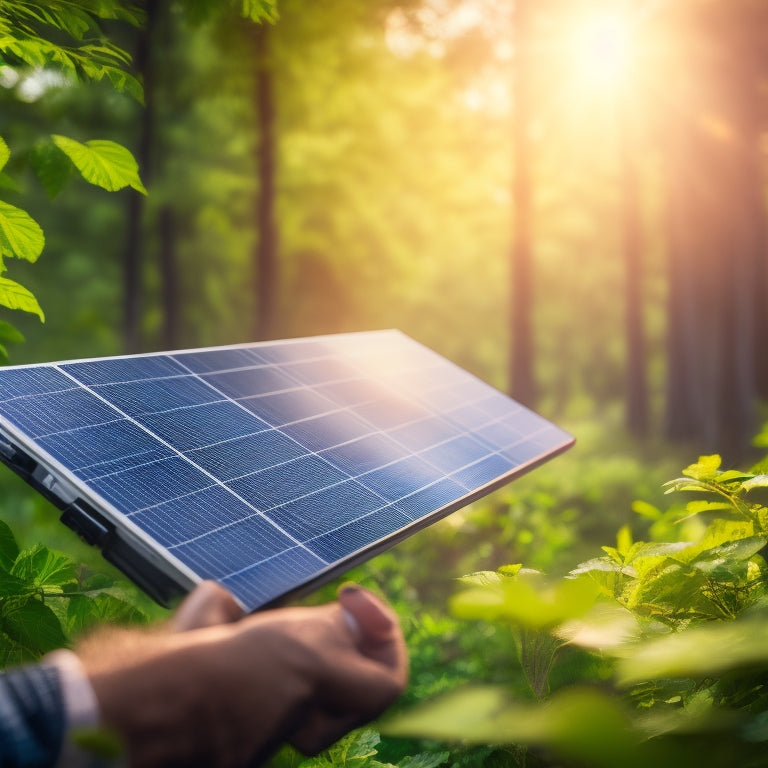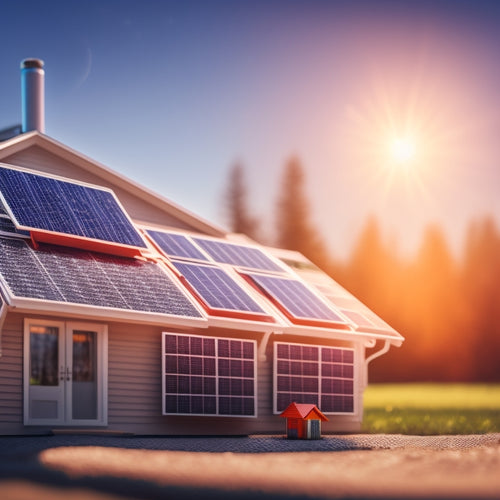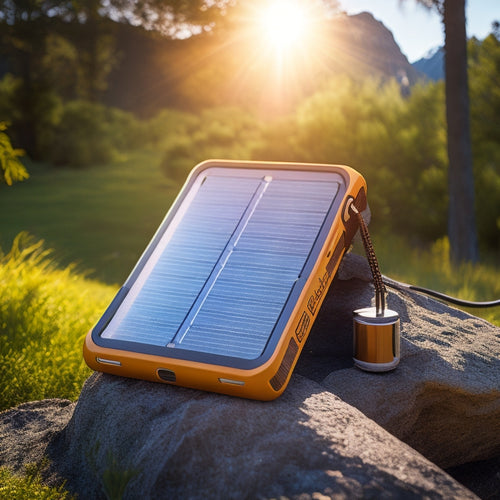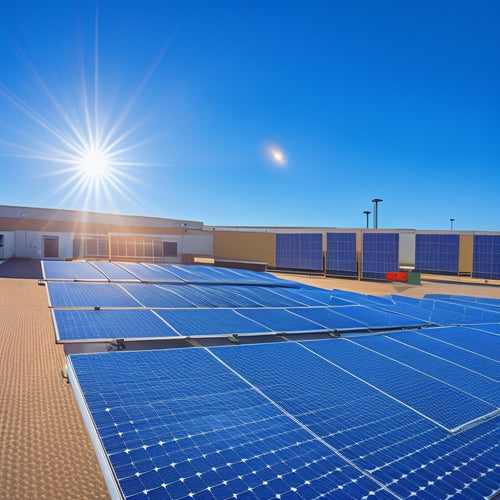
Maximize Your Energy Harvest With Regular Cleaning
Share
By establishing a regular cleaning schedule, you can prevent dust accumulation from reducing your solar energy harvest by up to 20%. Even a thin layer of dust can decrease energy output by 5%, so it's essential to clean your panels every 2-4 weeks, depending on environmental dust levels. Use a soft-bristled brush or specialized cleaning tool to avoid scratches, and avoid harsh chemicals or abrasive materials. By maintaining clean panels, you'll maximize energy output and prolong the lifespan of your solar installation - and there's even more to investigate to further optimize your energy harvest.
At a Glance
- Regular cleaning is crucial for maximizing energy harvest and maintaining peak performance, especially in residential solar panel systems.
- Dust can reduce solar panel energy output by up to 20%, and even a thin layer can reduce output by up to 5%.
- Cleaning frequency should be established based on environmental dust levels, with a recommendation of every 2-4 weeks.
- Use a soft-bristled brush or specialized cleaning tool to avoid scratches and ensure safe cleaning, avoiding harsh chemicals or abrasive materials.
- Advanced cleaning technologies, such as micro-scrubbing, offer deeper panel cleaning and outperform traditional techniques in removing dirt and debris.
Boost Panel Efficiency Fast
You'll want to prioritize dust removal essentials to guarantee your solar panels operate at their best, as even a thin layer of dust can reduce energy output by up to 20% Renewable Energy.
Additionally, proper installation by a reliable and trustworthy solar installation service provider is vital to guarantee quality workmanship and long-term system efficiency.
Next, adjust the angle of your panels to optimize energy absorption, as even slight misalignments can impact efficiency.
Dust Removal Essentials
With solar panels converting sunlight into electricity, even the slightest layer of dust can greatly impede their performance. As the owner of a solar panel system, you're probably aware that regular cleaning is essential to maximize energy harvest.
By integrating a battery storage system into your solar setup, you'll reveal the full potential of renewable energy and create a more sustainable, dependable, and cost-effective power solution off grid battery systems. However, it's vital to understand the importance of dust removal essentials to get the most out of your system.
You need to establish a cleaning frequency that suits your environment. If you live in an area with high dust collection, you may need to clean your panels more frequently. Typically, cleaning every 2-4 weeks is recommended, but this may vary depending on your location.
When cleaning, use a soft-bristled brush or a specialized solar panel cleaning tool to gently remove dust and debris. Avoid using harsh chemicals or abrasive materials that can scratch the panels.
Optimal Angle Adjustment
Adjusting your solar panels to the ideal angle is a significant step in maximizing energy harvest, as it allows them to capture the most sunlight possible. By optimizing the angle, you'll increase sunlight exposure, resulting in more energy generated.
To achieve this, you'll need to take into account your location's latitude, the time of year, and the panel's mounting system. When installing solar panels, it's important to guarantee a safe and secure installation process, which is why it's imperative to work with a professional solar panel installation company Renewable Energy Solutions.
In general, the ideal angle is equal to your latitude, with adjustments made for seasonal changes. For example, if you live at a latitude of 30°, your ideal angle would be around 30° during the summer months and 60° during the winter months.
However, this may vary depending on your specific situation, so be sure to consult with a professional or conduct further research.
Reduced Dust Accumulation Guaranteed
By regularly cleaning your solar panels, you'll guarantee dust-free panel surfaces that allow for ideal energy absorption.
This routine maintenance assures reduced dust accumulation, which is critical for maintaining peak performance, especially when it comes to residential solar energy systems that rely on photovoltaic panels.
With clean panels, you'll be able to maximize energy harvest and enjoy the full benefits of your solar investment.
Dust-Free Panel Surfaces
As you invest in solar energy, one vital aspect to prioritize is maintaining dust-free panel surfaces. Dust accumulation can markedly reduce energy output, making regular cleaning a fundamental task.
When panels are clean, you can expect peak performance and maximum energy harvest. Dust-free panel surfaces guarantee panel visibility enhancement, allowing sunlight to penetrate deeper into the panel's surface.
This, in turn, enhances sunlight absorption, resulting in increased energy production. Even a thin layer of dust can reduce energy output by up to 5%. Imagine the impact of prolonged dust buildup on your energy harvest.
Optimal Performance Maintenance
You've taken the first step towards maximizing energy harvest by maintaining dust-free panel surfaces.
Now, it's vital to guarantee peak performance maintenance to assure reduced dust accumulation and maximize your energy output. This involves implementing a routine inspection schedule to identify potential issues before they affect your system's performance. Regularly inspecting your panels and inverters will help you detect any signs of wear and tear, allowing you to address them promptly.
In addition to routine inspections, it's important to monitor your energy production closely. This can be achieved through energy monitoring systems that provide real-time data on your system's performance.
By analyzing this data, you'll be able to identify any anomalies or areas for improvement, enabling you to make data-driven decisions to enhance your energy harvest.
Advanced Water-Repellent Coating
You can markedly improve the water-repellent properties of your solar panels with a hydrophobic surface treatment, which reduces the contact angle between water and the panel's surface.
This, in turn, allows water to roll off easily, taking dirt and debris with it. By applying a durable nano-coating, you can guarantee this water-repellent effect lasts for a long time, even in harsh environmental conditions.
Additionally, a reliable power backup system is essential to guarantee a steady energy supply when the grid goes down, and clean solar panels play an important role in achieving this.
Hydrophobic Surface Treatment
Every solar panel installation can benefit from hydrophobic surface treatment, an advanced water-repellent coating that considerably reduces water's adhesive properties.
This treatment creates a self-cleaning effect, allowing water to roll off the surface easily, taking dirt and debris with it. You'll notice a significant reduction in water spots and mineral deposits, which can harm your panel's performance over time.
The hydrophobic surface treatment also enhances surface longevity by protecting your solar panels from corrosion and wear.
With this treatment, you can expect a longer lifespan for your panels, ensuring you generate the maximum amount of clean energy possible.
The treatment benefits are clear: reduced maintenance, improved performance, and increased energy output.
By investing in hydrophobic surface treatment, you're investing in the long-term health and efficiency of your solar panel installation.
With this advanced coating, you'll be utilizing the full potential of renewable energy and enjoying the freedom that comes with it.
Nano-Coating Durability
Two key factors determine the effectiveness of hydrophobic surface treatments: their water-repellent properties and durability. You can't have one without the other. A nano-coating that repels water like a charm but degrades quickly is as good as none. That's why nano-coating durability is essential in guaranteeing your energy-harvesting system operates at its finest.
When it comes to nano-coating applications, you want a coating that can withstand the elements and maintain its water-repellent properties over time. Durability testing is vital to determine the lifespan of the coating. This involves subjecting the coating to various environmental stresses, such as UV exposure, temperature fluctuations, and humidity, to see how well it holds up.
A durable nano-coating guarantees that your system remains efficient and effective, even in harsh environments. By choosing a coating that has undergone rigorous durability testing, you can have peace of mind knowing that your energy-harvesting system will continue to perform at its highest level, without the need for frequent cleaning or replacement.
Consider Inverter Compatibility Too
When selecting an inverter, you'll want to ascertain it's compatible with your solar panel system, which often includes residential solar panels and energy storage units.
The type of inverter you choose matters, as it can greatly impact your energy harvest, especially when paired with a grid tie inverter and charge controller.
You'll need to match the inverter's capacity to your system's capacity to maximize energy production.
Inverter Type Matters
By pairing your solar panels with the right inverter, you can unlock the full potential of your energy harvesting system. The type of inverter you choose plays a significant role in maximizing your energy output.
Inverter efficiency, for instance, directly affects the amount of usable energy you can generate. A high-efficiency inverter guarantees that more of the sun's energy is converted into electrical power, resulting in higher yields.
When selecting an inverter, consider its lifespan as well. A longer-lasting inverter reduces the need for frequent replacements, saving you time and money.
Furthermore, a high-quality inverter designed for your specific system configuration will optimize energy production and minimize losses. Don't settle for an inverter that's incompatible with your solar panels – it's a recipe for reduced energy output and increased maintenance costs.
Matching System Capacity
You've fine-tuned your energy harvesting system with the right inverter, but it's equally important to confirm your system's capacity matches its components. This guarantees you're not wasting energy or compromising your system's performance.
When your system capacity doesn't match its components, it can lead to reduced energy output, overheating, and even system failure.
To avoid these issues, you need to evaluate the maximum power point tracking (MPPT) capacity of your inverter. This will help you determine the ideal system capacity for your energy harvesting system.
For instance, if your inverter has an MPPT capacity of 5000 watts, you should verify your system capacity doesn't exceed this value. Exceeding the MPPT capacity will result in energy loss and reduced system efficiency.
Micro-Scrubbing Technology Outperforms
You can achieve deeper panel cleaning with micro-scrubbing technology, which uses gentle yet effective scrubbing motions to remove dirt and debris.
This results in a more thorough cleaning process that traditional methods can't match.
Deeper Panel Cleaning
Dust and debris accumulate on solar panels, reducing their energy output and efficiency. As you work to maximize your energy harvest, it's vital to go beyond routine cleaning and invest in deeper panel cleaning. This process involves using advanced technologies, such as micro-scrubbing, to remove stubborn dirt and grime that can compromise panel longevity.
By incorporating deeper cleaning into your maintenance routine, you can guarantee ideal energy production and extend the lifespan of your solar panels. Regular cleaning frequency is critical, as even a small amount of debris can greatly impact energy output.
Deeper cleaning helps remove microscopic particles that traditional cleaning methods may miss, restoring your panels to their ideal performance. To get the most out of your solar investment, consider incorporating deeper panel cleaning into your maintenance schedule.
This proactive approach will help you reap the rewards of clean energy while maintaining your freedom from reliance on traditional power sources. By taking control of your energy production, you can enjoy the peace of mind that comes with utilizing the power of the sun.
Frequently Asked Questions
Can I Clean My Solar Panels During the Winter Months?
You can clean your solar panels during winter months, but be cautious of icy conditions. Prioritize snow removal, especially after heavy snowfall, and perform winter maintenance tasks like clearing debris to guarantee peak energy production.
How Often Should I Check My Panels for Debris?
Truly, thou shouldst inspect thy panels every 2-3 months to combat debris accumulation; during winter, when snow and ice prevail, thou mayst need to check more frequently to guarantee peak energy production, lest thy panels be shrouded in darkness.
Will Cleaning My Panels Affect Their Warranty?
You're wondering if cleaning your panels will void their warranty. Don't worry, most manufacturers allow cleaning with approved techniques, ensuring you comply with warranty requirements.
Can I Use a Pressure Washer to Clean My Solar Panels?
Beware the spray, as a pressure washer's mighty force can shatter your solar panels' delicate glass. Instead, opt for a soft-bristle brush and mild soap for effective cleaning, ensuring safety and freedom from damage.
Are There Any Cleaning Products I Should Avoid Using?
When choosing cleaning materials for your solar panels, you'll want to avoid using harmful chemicals like abrasives, acidic substances, or wax-based products, as they can damage the panels' surface and reduce their efficiency.
Explore More
By prioritizing regular cleaning, you'll release your solar panels' full potential, banishing dust and debris that sap their strength. With advanced water-repellent coatings and micro-scrubbing technology, maintenance is a breeze. Don't forget to verify inverter compatibility for seamless energy harvesting. By taking these steps, you'll be bathing in the radiant glow of optimized energy production, your wallet and the planet thanking you in unison.
Related Posts
-

A Beginner's Guide to Navigating the Solar Investment Tax Credit
You're eligible to claim a significant Solar Investment Tax Credit (ITC) of 30% of total installation costs, but mane...
-

Fastest Solar Chargers for Emergency Power
When choosing the fastest solar chargers for emergency power, you need to focus on features like rapid charging capab...
-

Essential Solar Panel Mounts for Commercial Properties
When it comes to essential solar panel mounts for your commercial property, durability and wind resistance are key fa...


